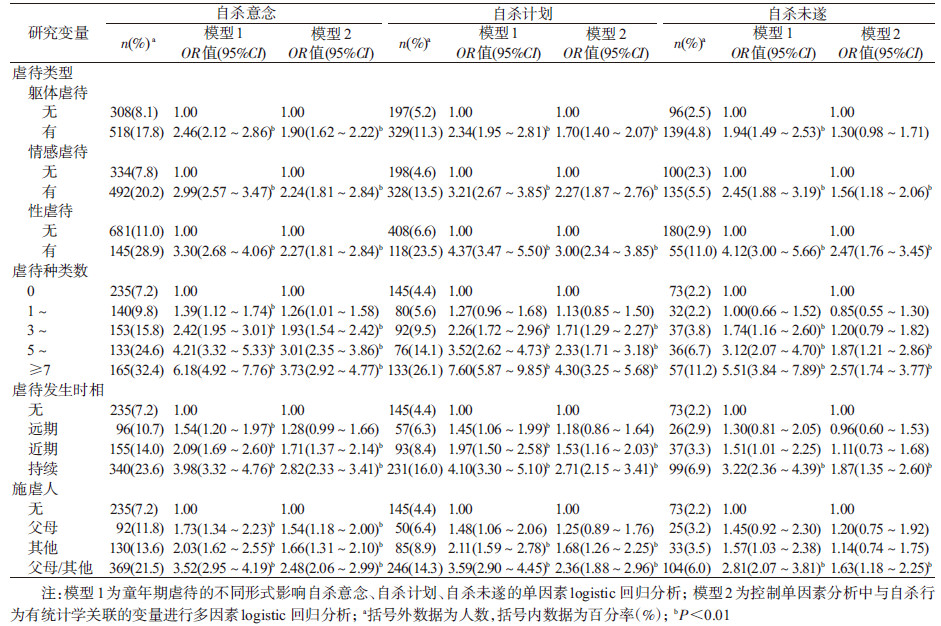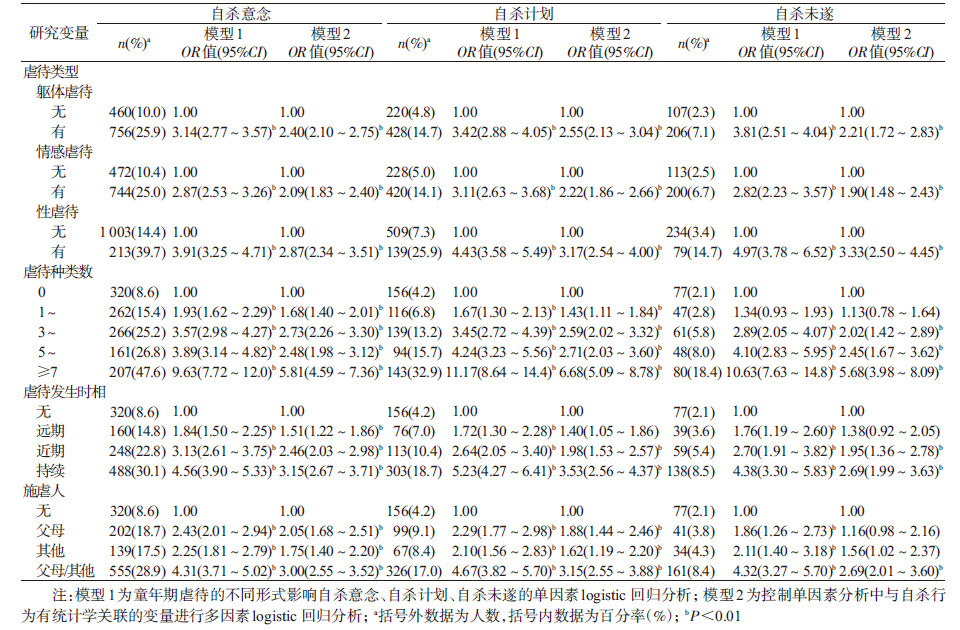文章信息
- 万宇辉, 刘婉, 孙莹, 郝加虎, 陶芳标.
- Wan Yuhui, Liu Wan, Sun Ying, Hao Jiahu, Tao Fangbiao.
- 童年期虐待的不同形式与中学生自杀行为关联性研究
- Relationships between various forms of childhood abuse and suicidal behaviors among middle school students
- 中华流行病学杂志, 2016, 37(4): 506-511
- Chinese Journal of Epidemiology, 2016, 37(4): 506-511
- http://dx.doi.org/10.3760/cma.j.issn.0254-6450.2016.04.013
-
文章历史
- 投稿日期: 2015-09-01
2. 230032 合肥, 安徽医科大学公共卫生学院儿少卫生与妇幼保健学系
2. Department of Maternal, Child and Adolescent Health, School of Public Health, Anhui Medical University, Hefei 230032, China
童年期虐待是指在相关责任、义务和能力的条件下各种形式的躯体、精神、性或其他形式的虐待[1]。童年期虐待经历会对受害者的终身健康产生长期不良效应,甚至引起残疾或早亡[2,3]。自杀行为是全世界普遍关注的公共卫生问题,现已成为危害青少年健康的重要因素。在我国,自杀是全人群伤害死因的第二位[4],也是15~34岁人群死因的第一位[5]。国内外许多文献提示,童年期虐待经历会增加青少年自杀意念和自杀未遂等自杀行为的发生风险[6,7]。同时有研究发现,童年期虐待的不同表现形式如虐待类型、种类数、发生时相和施虐人对后期心理行为问题的影响有较大差异[8,9],但不同虐待形式与青少年自杀行为的关联研究较少。因此,本研究分析童年期虐待的不同形式对中学生自杀行为的影响,为中学生自杀行为的防控提供参考。
对象与方法1.研究对象:2012年11-12月对广州、新乡、沈阳和重庆4个地区部分在校中学生进行身心健康问卷调查。通过整群抽样法,在各市抽取重点初中、普通初中、省示范高中、市示范高中各1所,以及农村普通初中2所、普通高中和市级示范高中各1所。每所学校抽取各年级3~4个班级全体学生进行调查。共发放问卷14 665份,其中有效问卷14 221份,有效应答率为97.0%。男生6 712人(47.2%),女生7 509人(52.8%);平均年龄为(15.1±1.9)岁。
2.研究变量:
(1)一般情况:包括性别(男、女)、年级(初一、初二、初三、高一、高二、高三)、户口所在地(农村、城镇)、独生子女(是、否)、父母文化程度(小学及以下、初中、高中、大专及以上)、自评家庭经济状况(较差、一般、较好)及亲密伙伴个数(0、1~2、≥3)等。
(2)童年期虐待:参考亲子冲突问卷[10]及美国CDC不良生活经历调查问卷-简版[11],制定包括3个维度共13个条目的童年期虐待评价问卷,其中童年期躯体虐待5个条目、情感虐待4个条目、性虐待4个条目。了解受试对象在16岁前相关虐待经历,将曾经发生的条目计为阳性条目,各维度中有1条以上的阳性条目即界定为有该类虐待经历的发生,任何维度中有阳性条目即界定为有童年期虐待。躯体、情感、性虐待和童年期虐待问卷的内部一致性良好,Cronbach’s α系数分别为0.826、0.784、0.830及0.871。合计各种虐待经历的阳性条目数(评分取值为0~13),分析随虐待阳性种类数的增加与自杀行为是否存在剂量反应关系。针对已发生的虐待经历,进一步了解虐待的发生时相和施虐人。虐待发生时相定义为“远期”(初中生9岁之前、高中生12岁之前)、“近期”(初中生9岁至调查日、高中生12~16岁)和“持续”3组。施虐人包括“父母”、“其他人”及“父母和其他人”3种类型。
(3)自杀行为:调查受试对象最近1年内以结束自己生命为目的的自杀行为,包括自杀意念(认真考虑过自杀)、自杀计划(制定过实施自杀的具体计划或过程)和自杀未遂(有过自杀行为但未成功)3组,考虑或实施次数≥1即判定为阳性[12]。
(4)心理病理状态:利用青少年亚健康多维评定问卷(MSQA)心理亚健康分量表[13,14,15]调查研究对象3个月以来实际感受的不适症状。该问卷包括情绪症状、品行问题和社会适应障碍3个维度,共39个条目,每个条目有6个评定等级(6=持续3个月及以上,5=持续2个月及以上,4=持续1个月及以上;3=持续2周及以上,2=持续1周及以上,1=无或持续1周以下),等级越高表示心理病理症状持续时间越长。合计心理亚健康症状持续时间>1个月(即4、5、6等级)的条目数,当该条目数≥8,则评定该研究对象为心理病理状态。
3.质量控制:根据知情同意的原则,要求学生在上课时间内完成问卷,约25 min。问卷调查使用统一的指导语,研究对象以班级为单位,匿名填写调查表。质控人员现场解答调查人员的疑问,并负责收集、审核调查表。在回收的问卷中,剔除前后有明显逻辑错误或漏填率5%以上的问卷。
4.统计学分析:采用EpiData 3.0软件录入资料,利用SPSS 16.0软件进行统计学分析。通过χ2检验比较不同性别中学生不同形式童年期虐待和自杀行为检出率的差异,并建立多因素logistic回归模型分析不同形式的童年期虐待对自杀行为的影响,鉴于研究样本量较大,分析变量入选标准为P<0.01。
结果1.不同形式的童年期虐待和自杀行为在男女生中的分布:51.0%的中学生有童年期虐待经历,男女生检出率(51.4% vs.50.6%)的差异无统计学意义(P>0.05)。男生躯体虐待的检出率高于女生,女生情感虐待的检出率高于男生,组间差异有统计学意义(P<0.01);男女生性虐待检出率的差异无统计学意义(P>0.01)。女生自杀意念的检出率高于男生,组间差异有统计学意义(P<0.01),而不同性别自杀未遂检出率的差异无统计学意义(P>0.01),见表 1。
2.童年期虐待的不同形式对男女生自杀行为的影响:控制相关混杂因素的作用后,童年期虐待经历会增加男生自杀意念(OR=2.03,95%CI:1.72~2.40)和自杀计划(OR=1.93,95%CI:1.57~2.37)的发生风险,增加女生自杀意念(OR=2.45,95%CI:2.12~2.82)、自杀计划(OR=2.46,95%CI:2.02~3.00)和自杀未遂(OR=2.12,95%CI:1.61~2.78)的发生风险。除童年期躯体虐待与男生自杀未遂外,不同类型的童年期虐待均是男女中学生自杀行为增加的危险因素(P<0.01)。随着童年期虐待种类数的增加,男女生自杀行为的发生风险呈增高趋势(P<0.01)。持续受虐以及施虐人为父母/其他的中学生,自杀行为的发生风险显著增加。女生中不同形式的虐待与自杀行为的关联相对强于男生,见表 2,3。
本研究显示,51.0%的中学生有童年期虐待经历,躯体、情感和性虐待的检出率分别为41.0%、38.0%和7.3%,检出率低于Lansford等[16]的研究,但明显高于其他的一些调查[17,18]。各种虐待类型检出率的性别差异也与现有报道存在一定差异[19,20]。可能与社会文化背景及不良经历的评价方法不同有关。本结果还显示,中学生过去1年自杀意念、自杀计划和自杀未遂的检出率分别为14.4%、8.3%和3.9%,略低于前期同地区中学生自杀行为的检出率(16.6%、9.6%和4.7%)[21],其中自杀意念的检出率也低于我国平均水平(17.99%)[22]。中学生自杀未遂率较高,虽明显低于美国青少年群体8.0%的检出率[22],但相对高于国内的部分调查[22],鉴于自杀未遂是自杀死亡的重要危险因素,并具有一定的示范作用,应引起足够重视。女生各种自杀行为,特别是自杀意念的检出率高于男生,性别差异与有关研究一致[23,24]。
调查总体显示,童年期躯体、情感和性虐待等是中学生自杀行为发生的重要危险因素;虽然男生躯体虐待对自杀未遂的作用受其他混杂因素的影响,但有躯体虐待经历的男生自杀未遂的检出率(4.8%)明显高于无躯体虐待经历者(2.5%),提示两者存在一定关联。有研究提示,不同类型的童年期不良经历(虐待、忽视及家庭功能不全等)与后期自杀行为的关联存在差异[25],但各种童年期虐待对后期自杀行为的不良影响已经得到许多研究的证实[26,27],提示早期虐待事件的不良健康效应可能更为显著。本结果还显示,随童年期虐待种类数的增加,中学生自杀行为的发生率也随之上升,两者关联的剂量反应关系也与其他多项研究一致[28,29],提示反复虐待经历会给受虐者带来更大的负面影响。
目前,各研究对虐待不同发生时相和施虐人对青少年自杀行为影响的认识还存在较大差异。本研究显示,近期发生虐待事件与自杀行为的关联相对强于远期虐待经历,而持续发生的虐待与自杀行为的关联更为显著。Thompson等[30]的研究显示,早期虐待经历(12岁之前)对青少年自杀意念的预测作用强于后期虐待经历(12~16岁),两个时期虐待经历的累积效应明显,但性别间差异并不显著。而Dunn等[31]的研究提示,各种虐待经历均会增加后期自杀意念的发生风险,与虐待的发生时相不存在显著关联。本研究提示,施虐人为父母/其他人的中学生,其自杀行为的发生风险显著增加。Cankaya等[32]的研究显示,如果性虐待经历的施虐人为父母,后期自杀行为会显著增加;我国有研究认为,各类施虐人均会增加男女青少年自伤行为的发生风险[9]。持续发生的虐待以及施虐人为父母/其他人与中学生自杀行为显著关联,也进一步证实了虐待经历的累积负性健康效应。此外,本研究显示,童年期虐待与女生自杀行为的关联强度总体高于男生,提示虐待经历可能对女生的负面作用更强,今后的研究需要对性别间的差异进行进一步的论证。
本研究尚存在局限性。首先,采用横断面调查,因此童年期虐待经历与中学生自杀行为的因果关系并不明确;其次,回顾性偏倚难以避免,童年期虐待和自杀行为评定的部分条目较为敏感,可能会影响调查对象的填写。
利益冲突 无| [1] WHO. Report of the consultation on child abuse prevention[M]. Geneva:World Health Organization,1999. |
| [2] Palusci VJ. Adverse childhood experiences and lifelong health[J]. JAMA Pediatr,2013,167(1):95-96. DOI:10.1001/jamapediatrics.2013.427. |
| [3] McCarthy M. Traumatic childhood experiences associated with chronic health problems,study finds[J]. BMJ,2014,349(dec0911):g7588. DOI:10.1136/bmj.g7588. |
| [4] 王黎君,刘韫宁,刘世炜,等. 1990年与2010年中国人群伤害疾病负担分析[J]. 中华预防医学杂志,2015,49(4):321-326. DOI:10.3760/cma.j.issn.0253-9624.2015.04.009. Wang LJ,Liu YN,Liu SW,et al. Status injury burden in 1990 and 2010 for Chinese people[J]. Chin J Prev Med,2015,49(4):321-326. DOI:10.3760/cma.j.issn.0253-9624.2015.04.009. |
| [5] Liu X,Sun Z,Yang Y. Parent-reported suicidal behavior and correlates among adolescents in China[J]. J Affect Disord,2008,105(1/3):73-80. DOI:10.1016/j.jad.2007.04.012. |
| [6] Miller AB,Esposito-Smythers C,Weismoore JT,et al. The relation between child maltreatment and adolescent suicidal behavior:a systematic review and critical examination of the literature[J] Clin Child Fam Psychol Rev,2013,16(2):146-172. DOI:10.1007/s10567-013-0131-5. |
| [7] Sigfusdottir ID,Asgeirsdottir BB,Gudjonsson GH,et al. Suicidal ideations and attempts among adolescents subjected to childhood sexual abuse and family conflict/violence:the mediating role of anger and depressed mood[J]. J Adolesc,2013,36(6):1227-1236. DOI:10.1016/j.adolescence.2013.10.001. |
| [8] Fisher HL,Jones PB,Fearon P,et al. The varying impact of type,timing and frequency of exposure to childhood adversity on its association with adult psychotic disorder[J]. Psychol Med,2010,40(12):1967-1978. DOI:10.1017/S0033291710000231. |
| [9] Wan YH,Chen J,Sun Y,et al. Impact of childhood abuse on the risk of non-suicidal self-Injury in mainland Chinese adolescents[J]. PLoS One,2015,10(6):e0131239. DOI:10.1371/journal.pone.0131239. |
| [10] Straus MA,Hamby SL,Finkelhor D,et al. Identification of child maltreatment with the Parent-Child Conflict Tactics Scales:development and psychometric data for a national sample of American parents[J]. Child Abuse Negl,1998,22(4):249-270. DOI:10.1016/S0145-2134(97)00174-9. |
| [11] Anda RF,Butchart A,Felitti VJ,et al. Building a framework for global surveillance of the public health implications of adverse childhood experiences[J]. Am J Prev Med,2010,39(1):93-98. DOI:10.1016/j.amepre.2010.03.015. |
| [12] 万宇辉,高荣,陶兴永,等. 大学生故意自伤行为与自杀行为的相关性研究[J]. 中华流行病学杂志,2012,33(5):474-477. DOI:10.3760/cma.j.issn.0254-6450.2012.05.006. Wan YH,Gao R,Tao XY,et al. Relationship between deliberate self-harm and suicidal behaviors in college students[J]. Chin J Epidemiol,2012,33(5):474-477. DOI:10.3760/cma.j.issn. 0254-6450.2012.05.006. |
| [13] 齐秀玉,陶芳标,胡传来,等. 中国青少年亚健康多维问卷编制[J]. 中国公共卫生,2008,24(9):1025-1028. Qi XY,Tao FB,Hu CL,et al. Study on of multidimensional sub-health questionnaire of adolescents[J]. Chin J Public Health,2008,24(9):1025-1028. |
| [14] 邢超,陶芳标,袁长江,等. 青少年亚健康多维评定问卷信度和效度评价[J]. 中国公共卫生,2008,24(9):1031-1033. Xing C,Tao FB,Yuan CJ,et al. Evaluation of reliability and validity of the multidimensional sub-health questionnaire of adolescents[J]. Chin J Public Health,2008,24(9):1031-1033. |
| [15] 陶芳标,邢超,袁长江,等. 青少年亚健康多维评定问卷的全国常模研制[J]. 中国学校卫生,2009,30(4):292-295. Tao FB,Xing C,Yuan CJ,et al. Development of national norm for multidimensional sub-health questionnaire of adolescents(MSQA)[J]. Chin J Sch Health,2009,30(4):292-295. |
| [16] Lansford JE,Alampay LP,Al-Hassan S,et al. Corporal punishment of children in nine countries as a function of child gender and parent gender[J]. Int J Pediatr,2010,2010:672780. DOI:10.1155/2010/672780. |
| [17] Schüssler-Fiorenza Rose SM,Xie D,Stineman M. Adverse childhood experiences and disability in U.S. adults[J]. PM R,2014,6(8):670-680. DOI:10.1016/j.pmrj.2014.01.013. |
| [18] Shen LJ,Zhang YL,Liang W,et al. Investigation of child maltreatment:survey among junior school pupils in Henan province of China[J]. Asia Pac Psychiatry,2015,7(1):85-90. DOI:10.1111/appy.12105. |
| [19] Harford TC,Yi HY,Grant BF. Associations between childhood abuse and interpersonal aggression and suicide attempt among U. S. adults in a national study[J]. Child Abuse Negl,2014,38(8):1389-1398. DOI:10.1016/j.chiabu.2014.02.011. |
| [20] UNICEF. Hidden in plain sight:a statistical analysis of violence against children[M]. New York:UNICEF,2014. |
| [21] Kann L,Kinchen S,Shanklin SL,et al. Youth risk behavior surveillance-United States,2013[J]. MMWR Surveill Summ,2014,63 Suppl 4:1-168. |
| [22] 杨冬梅,韩卫民,邵春昕,等. 北京市通州区中学生2008-2012年自伤与自杀行为监测结果[J]. 中国学校卫生,2013,34(11):1351-1353,1358. Yang DM,Han WM,Shao CX,et al. Surveillance for self-injury and suicide among middle school students in Beijing Tongzhou distinct during 2008-2012[J]. Chin J Sch Health,2013,34(11):1351-1353,1358. |
| [23] 陈静,万宇辉,孙莹,等. 中学生睡眠问题与自杀行为的相关性研究[J]. 中华流行病学杂志,2014,35(2):129-133. DOI:10.3760/cma.j.issn.0254-6450.2014.02.006. Chen J,Wan YH,Sun Y,et al. Relations between problems on sleeping and suicidal behaviors in middle school students[J]. Chin J Epidemiol,2014,35(2):129-133. DOI:10.3760/cma.j.issn.0254-6450.2014.02.006. |
| [24] 常微微,姚应水,袁慧,等. 2000-2012年我国中发生率的Meta分析学生自杀意念[J]. 中华流行病学杂志,2013,34(5):515-519. DOI:10.3760/cma.j.issn.0254-6450.2013.05.022. Chang WW,Yao YS,Yuan H,et al. Prevalence of suicide ideation among middle school students in China:a systematic analysis of studies between 2000 and 2012[J]. Chin J Epidemiol,2013,34(5):515-519. DOI:10.3760/cma.j.issn.0254-6450. 2013.05.022. |
| [25] Bruwer B,Govender R,Bishop M,et al. Association between childhood adversities and long-term suicidality among South Africans from the results of the South African Stress and Health study:a cross-sectional study[J]. BMJ Open,2014,4(6):e004644. DOI:10.1136/bmjopen-2013-004644. |
| [26] Devries KM,Mak JY,Child JC,et al. Childhood sexual abuse and suicidal behavior:a meta-analysis[J]. Pediatrics,2014,133(5):e1331-1344. DOI:10.1542/peds.2013-2166. |
| [27] Barbosa LP,Quevedo L,da Silva Gdel G,et al. Childhood trauma and suicide risk in a sample of young individuals aged 14-35 years in southern Brazil[J]. Child Abuse Negl,2014,38(7):1191-1196. DOI:10.1016/j.chiabu.2014.02.008. |
| [28] Cluver L,Orkin M,Boyes ME,et al. Child and adolescent suicide attempts,suicidal behavior,and adverse childhood experiences in south Africa:a prospective study[J]. J Adolesc Health,2015,57(1):52-59. DOI:10.1016/j.jadohealth.2015.03. 001. |
| [29] Bruffaerts R,Demyttenaere K,Borges G,et al. Childhood adversities as risk factors for onset and persistence of suicidal behaviour[J]. Br J Psychiatry,2010,197(1):20-27. DOI:10.1192/bjp.bp.109.074716. |
| [30] Thompson R,Litrownik AJ,Isbell P,et al. Adverse experiences and suicidal ideation in adolescence:exploring the link using the LONGSCAN samples[J]. Psychol Violence,2012,2(2). DOI:10.1037/a0027107. |
| [31] Dunn EC,McLaughlin KA,Slopen N,et al. Developmental timing of child maltreatment and symptoms of depression and suicidal ideation in young adulthood:results from the National Longitudinal Study of Adolescent Health[J]. Depress Anxiety,2013,30(10):955-964. DOI:10.1002/da.22102. |
| [32] Cankaya B,Talbot NL,Ward EA,et al. Parental sexual abuse and suicidal behaviour among women with major depressive disorder[J]. Can J Psychiatry,2012,57(1):45-51. |
 2016, Vol. 37
2016, Vol. 37





